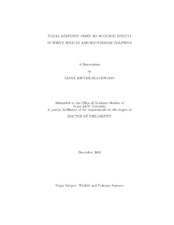| dc.description.abstract | Response times have been used to explore cognitive and perceptual processes since 1850 (Donders, 1868). The technique has primarily been applied to humans, birds, and terrestrial mammals. Results from two studies are presented here that examine response times in bottlenose dolphins (Tursiops truncatus) and white whales (Delphinapterus leucas). One study concerned response times to stimuli well above the threshold of perceptibility of a stimulus, and the other concerned response times to stimuli near threshold. Two white whales (Delphinapterus leucas) and five Atlantic bottlenose dolphins (Tursiops truncatus) were presented stimuli well above threshold. The stimuli varied in type (tone versus pulse), amplitude, duration, and frequency. The average response time for bottlenose dolphins was 231.9 ms. The average response time for white whales was 584.1 ms. There was considerable variation between subjects within a species, but the difference between species was also found to be significant. In general, response times decreased with increasing stimulus amplitude. The effect of duration and frequency on response time was unclear. Two white whales (Delphinapterus leucas) and four Atlantic bottlenose dolphins (Tursiops truncatus) were given audiometric tests to determine masked hearing thresholds in open waters of San Diego Bay (Ridgway et al., 1997). Animals were tested at six frequencies over a range from 400 Hz to 30 kHz using pure tones. Hearing thresholds varied from 87.5 dB to 125.5 dB depending on the frequency, masking noise intensity and individual animal. At threshold, median response time across frequencies within each animal varied by about 150 ms. The two white whales responded significantly slower (∼670 msec, p<0.0001) than the four dolphins (∼410 msec). As in terrestrial animals, reaction time became shorter as stimulus amplitude increased (Wells, 1913; Stebbins, 1966). Across the two studies, the dolphins as a group were faster in the abovethreshold study than in the nearthreshold study. White whales had longer response times than bottlenose dolphins in both studies. Analysis of response time with an allometric relation based on weight shows that the difference in weight can explain a significant part of the difference in response time. | en |


